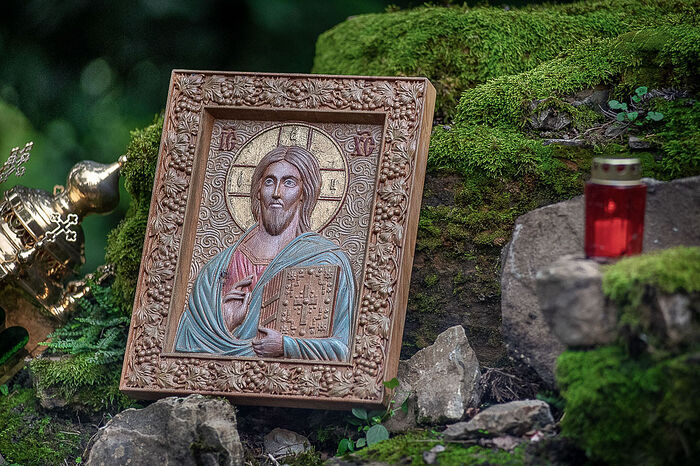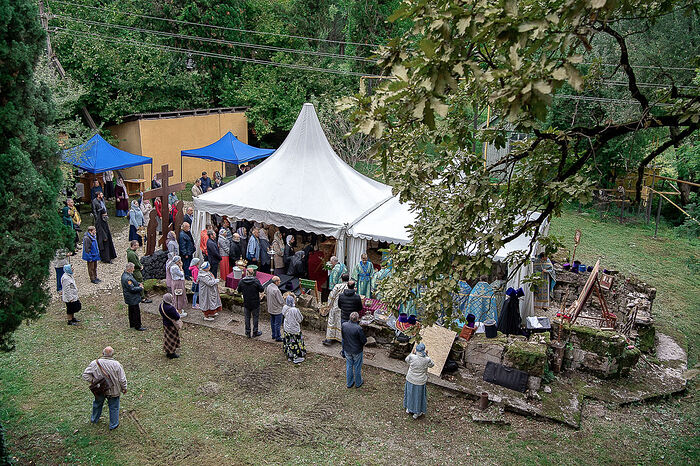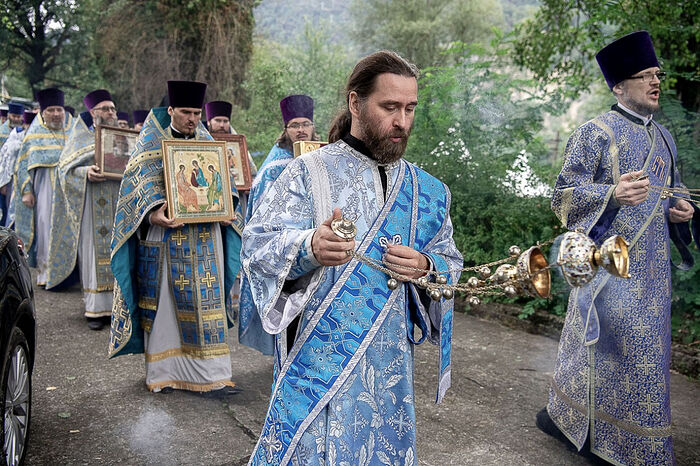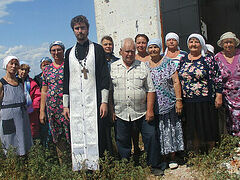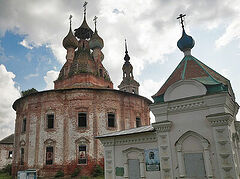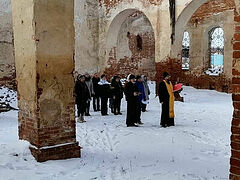On September 23, a significant event took place in the Diocese of Sochi and Tuapse, when Bishop German presided over the first Divine Liturgy in the ruined Holy Trinity Monastery. It’s located on a mountain, 1,640 feet from the road to Krasnaya Polyana. As you’re riding from Adler, you see a stop called “Monastery.” It was also called this under the communists. The monastery wasn’t visible, but the stop, with such an unusual name for the atheistic regime, was. It’s strange, but no one from Krasnaya Polyana (not even the church-goers) could tell me about the monastery and where it was located. They only said: “It used to be there.” I was unlucky. It’s just that I asked the wrong people. Meanwhile, many not only knew about the monastery, but would also come on the feast of Pentecost, bringing icons and candles and praying before the moss-covered stones left over from the altar apse of the Holy Trinity Church.
On the day of the first Liturgy in the 99 years since it was ruined, they were calling for rain from morning till evening, so two tents were pitched over the old remains. So, the service wasn’t quite under the open sky, but rather, under the open sky for those who didn’t find room under the tents. The sky was gloomy starting in the morning. The low clouds threatened to rain at any moment. But they served a moleben—no rain. They greeted Vladyka—not a drop. Liturgy ended, we had a procession, we heard a homily from Bishop German, and only then did the promised rain begin.
Next year will mark the sad centenary of the destruction of the monastery. And this first Liturgy was a great joy not only for the Sochi clerics and the many believers who came to the feast from faraway parishes… As Vladyka German noted, on this day, the angel of the Holy Trinity Church ceased his mourning.
Some of those gathered for the celebration developed the idea about joy in Heaven: There must be a special Russian place in the Kingdom of Heaven for angels grieving over the tens of thousands of ruined monasteries and churches. And for them, the first Liturgy in the Holy Trinity Church was a great comfort. God-willing, their monasteries will begin to be restored.
Vladyka German spoke about a clear sign of God’s favor: The day before, a woman brought an icon of the Theotokos her relatives had saved during the destruction of the monastery. Her family had kept this sacred item for an entire century, in anticipation of the day when they’d be able to return it to its place.
Vladyka called on the faithful to take part in the upcoming work on the construction of the church and monastery buildings and told about the history of its founding. The monastery existed for only twenty years—from 1902 to 1922. 110 people labored there. During this time, the monks built a church, a resident for the brethren, an abbot’s house, a hospital, a trapeza, and buildings that housed a kitchen, a prosphora shop, a laundry room, a sauna, a smithy, and all the services needed for a full-fledged monastic life. A garden was planted on five desiatinas,[1] a garden was laid out on three, and a vineyard on two. Arable land and hayfields took up twenty desiatinas. Bulls and horses were purchased for the work. There was a brick-making factory. Altogether, there were 213 desiatinas of land, and later, more were added, up to 400 desiantinas. The monastery wasn’t rich, but it was renowned for its hospitality. It had dependencies in Adler and Medoveyevka. Pilgrims visited the monastery often. Hermits from cells near and far would come to the services.
The monastery was ravaged at the same time as New Athos Monastery. Several monks were shot. Many were exiled and sent to camps. Some managed to escape to the mountains, but the godless authorities didn’t leave them alone for long. Hermits near the village of Pskhu were rounded up in a military operation. The sketes and cells were destroyed, and the monks were treated as the worst enemies of the soviet government.
There are some interesting details about how the monastery was founded. Hieromonk Markian and the retired collegiate assessor Nikolai Sokolov began working on the establishment of a new monastery in 1900. Fr. Markian had rich experience of monastic work on Mt. Athos and the construction of the Kyzyltash Cenobium in Crimea and St. Michael’s Athos Hermitage in the Maykop District in the Caucasus. It was necessary work, but getting permission turned out to be difficult.
It should be remembered that since the annexation of Crimea and the northern coast of the Black Sea, Russian sovereigns took care to create spiritual centers on these new Russian lands. Nicholas Pavlovich [Tsar Nicholas I] dreamed of Crimea becoming a new Athos. He would say, “Russian men have nothing to do with Greeks. They must be returned to Russia and given land in Crimea.” The emperor’s dream was partially realized. Several dozen sketes and cells were formed on Mt. Ayu-Dag in the Partenit area alone.
Half a century later, Tsar Alexander III “expressed the desire to establish as many monasteries as possible in the Caucasus for the enlightenment and strengthening of Orthodoxy, and thus there would be no obstacles to land being allotted.” But by the beginning of the twentieth century, in the 600 versts[2] from Kerch to New Athos, there wasn’t a single monastery. Hieromonk Markian pointed this out in his petition, substantiating the need to build a monastery in the Black Sea Governorate and to allocate state land for it. Permission was granted. By supreme command of the Sovereign Emperor Nicholas Alexandrovich [Tsar Nicholas II], on June 22, 1902, the Holy Synod issued a decree on the establishment of Holy Trinity Monastery with the allocation of state land for its needs. But two years passed from the submission of the petition till its satisfaction, during which time the petitioners were very anxious…
For two years, they corresponded with the Synod and various ministries to eliminate any unforeseen obstacles and to start working. There was no Black Sea Diocese at that time, and the land was under the jurisdiction of the Georgian Exarchate. Vladyka Flavian, the Georgian Exarch, agreed to the establishment of the monastery and sent a petition to the Holy Synod to allocate a plot for its needs twenty versts from Tuapse. The petition was granted. But then the difficulties began. Nikolai Savvich Abaza, the Chairman of the Special Commission for drafting legislative provisions on the arrangement of the Black Sea coast decided that it was better to divide the land near the coast into plots and sell it for dachas and sanatoriums. And so they did. So they had to start looking for a plot for the monastery far from the sea.
A plot was found twenty versts from Adler “in the area of Mt. Akhtsu, at the confluence of the Psakho and Mzymta Rivers.” The distance from the highway to the site varied in official documents—in some it was half a verst, in others two. But the place was picturesque and secluded and therefore suited for monastic work, and the petitioners were satisfied.
But the difficulties didn’t end there. In the documentation, the future monastery was listed as “located twenty versts from Tuapse, in the direction of Novorossiysk.” But in fact, it was a hundred and fifty versts from Tuapse, in the direction of Sukhum. Moreover, the Ministry of Internal Affairs gave its permission to build a monastery near Tuapse. The poor retired collegiate assessor Sokolov foresaw great difficulties in connection with the confusion in the location of the monastery and constantly appealed to the Synod to fix the errors in the documentation. It took two years. But the emperor immediately signed the decree on the foundation of the monastery as soon as he received the papers from the Synod. It coincided with Tsar Nicholas Alexandrovich’s desire to create a spiritual center in southern Russia near the resorts at Krasnaya Polyana and on the Black Sea coast.
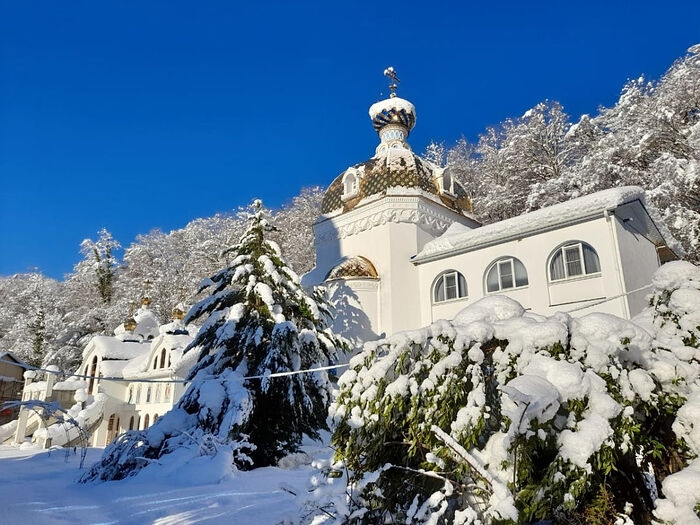 Holy Trinity-St. George Convent, Sochi, Lesnoe village
Holy Trinity-St. George Convent, Sochi, Lesnoe village
So the merit of Vladyka German in the revival of the monastery has yet to be evaluated. He managed to achieve the return of the monastery lands and the buildings left on them rather quickly. The fact is that the authorities had already given permission for the restoration of the Holy Trinity Monastery back in 1991, although in a new place, since the Prosecutor General of the USSR (and then Russia) had a dacha on its territory. Land was allocated in the village of Lesnoe, and the Holy Trinity-St. George Monastery was opened in memory of the ruined Holy Trinity Monastery (though now a convent). At that time, no one could have thought it possible to rebuild the former monastery in its historical place. The fact that Vladyka German has managed to do this was seen by many as a miracle of God.
It truly is a miracle. At a time when churches in Europe are being given away for bars and entertainment venues, on the Black Sea coast they’re building churches. There are more than fifty churches and chapels designed by the architect Theodore Afuksenidi alone. And the process of building churches continues. Archpriest Valentin Sventsitsky, in his book about visiting monks who labored in these places, called them “citizens of Heaven.”
May God grant that the work of the ascetics who built monasteries in pre-revolutionary Russia, and the modern continuers of their podvigs might bear good fruit, and that the Black Sea region and all of Russia might become a “land aspiring to Heaven.”

